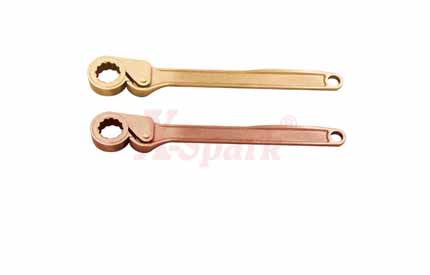What Is a Non-Sparking Tool?
The non-sparking tools are made of nonferrous metals, which means they are iron-free alloys. They have two unique properties. First, as the name implies, non-sparking tools do not generate sparks. This makes it very suitable for work involving flammable conditions. Also due to the lack of iron, a second unique property is that they are also non-magnetic tools. Having a comprehensive, proactive safety and health management system, especially in industries with a high risk of explosion or fire, is one of the most important factors in reducing workplace hazards and injuries (mainly caused by unsafe behaviors or conditions). Choosing the right non-sparking tool will minimize the risk of these potential explosion areas or explosions.
After defining the area and environment in which we use the explosion-proof tool, one of the most important characteristics to consider when choosing the right tool is the right material, depending on the type of tool and its purpose. Many materials do not produce sparks, but tools require considerable resistance and can be used under good conditions.
It is important to select and use the right tools for a given task, which allows the worker to execute it in less time and move on to a new task. Choosing the right non-sparking tool can not only help prevent accidents, but also avoid high costs to the company, such as damage to infrastructure, materials to be repaired, or even the cost of accidents.
It is important to remember that non-sparking tools are not as strong as steel tools. As a result, they wear out more quickly depending on the work environment and maintenance requirements. Detailed maintenance of tools is strongly recommended to extend tool life. Please consider the following suggestions:
Select the right size for the correct task to prevent tool drops.
Avoid contact with corrosive products, such as iron or other contaminants that may affect the non-sparking properties.
Clean non-sparking tools after use to avoid damage.
Do not use non-spark tools in the presence of acetylene, as it can cause explosive acetylene.
Always check tools that are free of wear, such as hammers or hitting wrenches.
Hammers and wrenches can be very dangerous tools. If handled incorrectly and carefully, a wrench or hammer can fall or fly away, posing a significant risk, which can lead to serious injury.

Keep sparkless tools clean and free of iron or other contaminants, which may impair their non-sparking performance.
Keep sparkless tools clean and free of iron or other contaminants, which may impair their sparkless performance.
Do not use a non-sparking hand tool in direct contact with acetylene as explosive acetylene may form, especially in wet conditions.
During normal use, all hammers and chisels will gradually cause some damage to the striking surface of the hammer or the cutting edge and striking end of the chisel. As part of normal operation and safety procedures, these tools, like steel tools, shall be returned to the workshop for face and head trimming. This is essential to prevent eye damage caused by chips falling off items during use.
Do not store hammers and other hand tools with wooden handles where they may dry out and contract. This increases the risk of a broken handle or loosehead.
Avoid excessive impact to avoid damaging the shaft. Replacement handles are usually available from the manufacturer and should be installed by a qualified operator using an approved installation method, with special attention to wedge installation.
Fiberglass handles provide an advantage over wood handles in terms of fracture stress and resistance to adverse environmental conditions. The fiberglass shaft fails gradually, rather than catastrophically, reducing the risk of sudden failure, injury, or damage.
When selecting a wrench, the jaw should be tightly screwed to the head of the nut or bolt to be tightened. This is especially true for non-spark tools, which usually do not have the hardness of steel tools.
Tools are designed for a specific purpose. As with any tool, no additional torque should be applied by using the "cheater bars". In addition to the possibility of tool damage, this is a dangerous approach to operator safety. Wrenches should not be used as levers; A screwdriver cannot be pushed like a chisel and so on.
In addition to any special recommendations arising from the alloys used, non-spark handheld tools must also adopt the accepted safety and maintenance standards for universal steel handheld tools.
When sharpening non-spark safety tools, follow normal safety procedures, such as providing eye and face protection, adequate ventilation, and dust collection facilities.